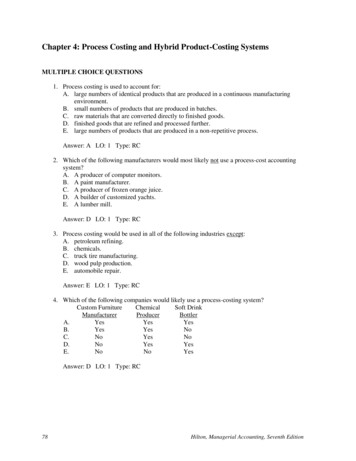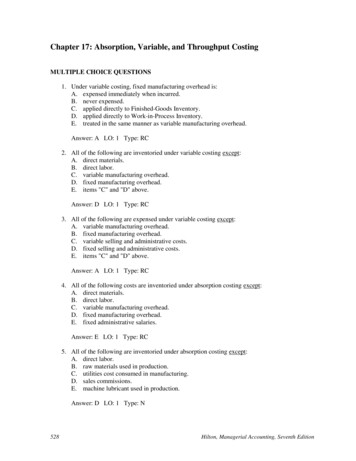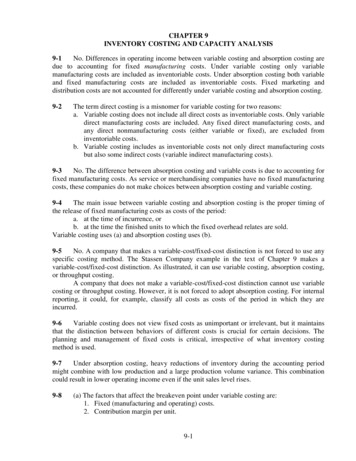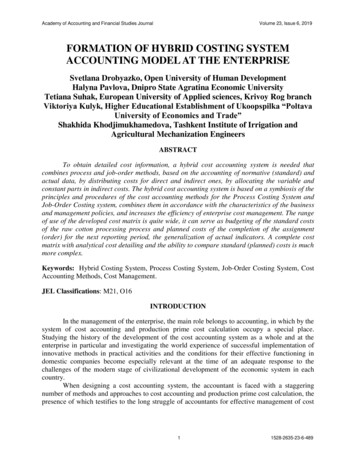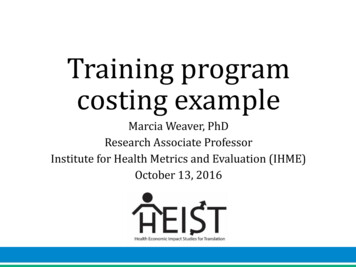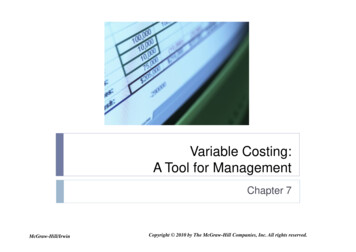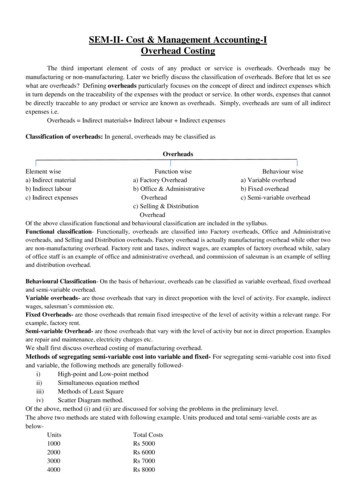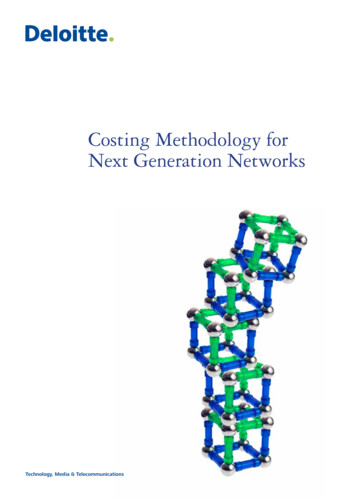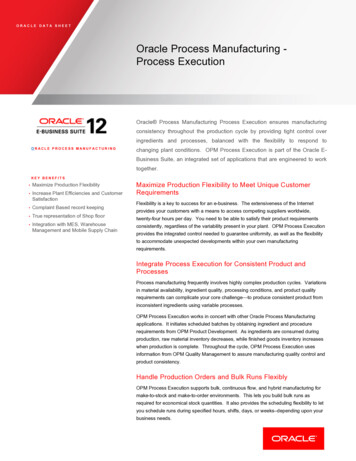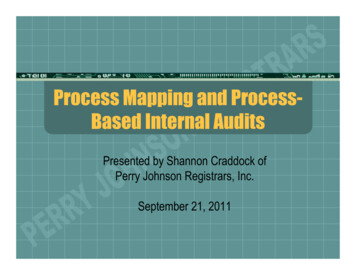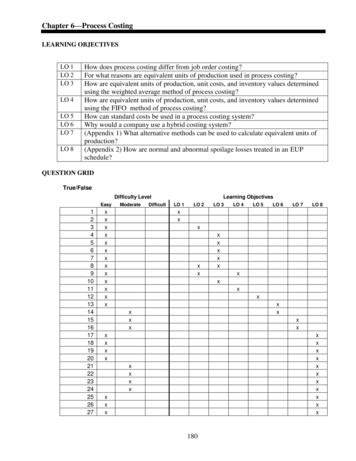
Transcription
Chapter 6—Process CostingLEARNING OBJECTIVESLO 1LO 2LO 3LO 4LO 5LO 6LO 7LO 8How does process costing differ from job order costing?For what reasons are equivalent units of production used in process costing?How are equivalent units of production, unit costs, and inventory values determinedusing the weighted average method of process costing?How are equivalent units of production, unit costs, and inventory values determinedusing the FIFO method of process costing?How can standard costs be used in a process costing system?Why would a company use a hybrid costing system?(Appendix 1) What alternative methods can be used to calculate equivalent units ofproduction?(Appendix 2) How are normal and abnormal spoilage losses treated in an EUPschedule?QUESTION GRIDTrue/FalseDifficulty 2627ModeratexxxxxxxxxxxxxDifficultLearning ObjectivesLO 1LO 2LO 3LO 4LO 5LO 6LO 7LO 8xxxxxxxxxxxxxxxxxxxxxxxxxxxxxxxxxxxxxxxxxxx180
CompletionDifficulty LevelEasy1x2x3x4x5x6x78xMultiple ChoiceModerateDifficultLearning ObjectivesLO 1LO 2LO 30313233343536LO 5LO 6LO 7LO 8xxxxxxDifficulty LevelEasyLO 4xxxModeratexxxxxDifficultxLearning ObjectivesLO 1LO 2LO 3LO 4xxxxLO 5LO 6LO 7LO xxxxxxxxxxxxxxxxxxx181
Difficulty 28384ModerateLearning ObjectivesDifficultLO 1LO 2LO 3LO 4XLO 5LO 6LO 7LO xxXxxx182xx
Difficulty 20121122123Short-AnswerModerateLearning ObjectivesDifficultLO 1xxxxxxxxXXxxXXXXXXLO 2LO 3xxxxxxxxxxxxxxxxxxxxxxxxxxxxxxxxxxxxxxxxLO 6LO 7LO 8xxxxxxxxxxxxxxxxxxXXXXxxXXXXXXxxxxEasyLO ifficulty Level1234567LO 4Learning ObjectivesDifficultLO 1xxxxxxxLO 2LO 3LO 4xxxLO 5LO 6LO 7LO 8xxxxx183
ProblemDifficulty LevelEasy123456789101112131415ModerateLearning ObjectivesDifficultLO 1xxxxxxxxxxxxxxxLO 2LO 3LO 4xxxxxxxxxxxxxxxxxxxxxx184LO 5LO 6LO 7LO 8xxxxxxxx
TRUE/FALSE1. Process costing is most appropriate when manufacturing large batches of homogenous products.ANS: TDIF: EasyOBJ: 6-12. Conversion costs include all manufacturing costs other than direct materialsANS: TDIF: EasyOBJ: 6-13. Equivalent units are computed to assign costs to partially completed unitsANS: TDIF: EasyOBJ: 6-24. The weighted average method combines beginning inventory and current production to compute costper unit of production.ANS: TDIF: EasyOBJ: 6-35. The FIFO method combines beginning inventory and current production to compute cost per unit ofproduction.ANS: FDIF: EasyOBJ: 6-36. The weighted average method separates beginning inventory and current production to compute costper unit of production.ANS: FDIF: EasyOBJ: 6-37. The FIFO method separates beginning inventory and current production to compute cost per unit ofproduction.ANS: TDIF: EasyOBJ: 6-38. The numerator in the formula for equivalent units includes all beginning inventory costs when usingthe weighted average costing assumption.ANS: TDIF: EasyOBJ: 6-2,6-39. The numerator in the formula for equivalent units includes all beginning inventory costs when usingthe FIFO costing assumption.ANS: FDIF: EasyOBJ: 6-2,6-410. The weighted average costing method assumes that units in beginning inventory are the first unitstransferred.ANS: FDIF: EasyOBJ: 6-311. The FIFO costing method assumes that units in beginning inventory are the first units transferred.ANS: TDIF: EasyOBJ: 6-4185
12. Standard costing is compatible with both FIFO and weighted average methods of costingANS: FDIF: ModerateOBJ: 6-513. A hybrid costing system would be appropriate for a company that manufactures cake flour.ANS: FDIF: EasyOBJ: 6-614. A hybrid costing system would be appropriate for a company that manufactures several varieties ofjam.ANS: FDIF: ModerateOBJ: 6-615. Using FIFO costing, equivalent units of production (EUP) can be determined by subtracting EUP’s inBeginning work in process from weighted average EUP.ANS: TDIF: ModerateOBJ: 6-716. Weighted average equivalent units of production (EUP) can be determined by adding EUP’s in endingwork in process to units transferred out.ANS: TDIF: ModerateOBJ: 6-717. Continuous production losses are assumed to occur uniformly throughout the process.ANS: TDIF: EasyOBJ: 6-818. Discrete production losses are assumed to occur throughout the process.ANS: FDIF: EasyOBJ: 6-819. Discrete production losses are assumed to occur at the end of a process.ANS: TDIF: EasyOBJ: 6-820. Continuous production losses are assumed to occur at the end of a processANS: FDIF: EasyOBJ: 6-821. Abnormal continuous losses are absorbed by all units in ending inventory and transferred out on aEUP basis.ANS: FDIF: ModerateOBJ: 6-822. Normal continuous losses are absorbed by all units in ending inventory and transferred out on a EUPbasis.ANS: TDIF: ModerateOBJ: 6-8186
23. Costs of normal shrinkage and normal continuous losses in a process costing environment are handledby the method of neglect.ANS: TDIF: ModerateOBJ: 6-824. Costs of normal shrinkage and normal continuous losses in a process costing environment are handledby the method of accretion.ANS: FDIF: ModerateOBJ: 6-825. A continuous loss is assumed to occur at a specific point in the production process.ANS: FDIF: EasyOBJ: 6-826. A discrete loss is assumed to occur at a specific point in the production process.ANS: TDIF: EasyOBJ: 6-827. Abnormal spoilage is always accounted for on an equivalent unit basis.ANS: TDIF: EasyOBJ: 6-8COMPLETION1. All manufacturing costs other than direct materials are referred to asANS: conversion costsDIF: EasyOBJ: 6-12. The process costing system that computes equivalent units on beginning work in process inventory aswell as work done in the current period is known as a .ANS: weighted average process costing methodDIF: EasyOBJ: 6-13. The process costing system that computes equivalent units on work done in the current period isknown as a .ANS: FIFO process costing methodDIF: EasyOBJ: 6-14. The number of completed units that could have been produced from the inputs applied is referred to as.ANS: equivalent unitsDIF: EasyOBJ: 6-2187
5. Two methods of accounting for cost flows in process costing are and .ANS: weighted average; FIFODIF: EasyOBJ: 6-36. A costing system is appropriate where products manufactured have different directmaterials but similar processing techniques.ANS: hybridDIF: EasyOBJ: 6-67. Costs of normal shrinkage and normal continuous losses in a process costing environment are handledby the method of .ANS: neglectDIF: ModerateOBJ: 6-88. The report details all manufacturing quantities and costs, showscomputation of EUP, and indicates cost assignments to goods manufactured.ANS: cost of productionDIF: EasyOBJ: 6-3,6-4MULTIPLE CHOICE1. Which cost accumulation procedure is most applicable in continuous mass-production manufacturingenvironments?a. standardb. actualc. processd. job orderANS: CDIF: EasyOBJ: 6-12. Process costing is used in companies thata. engage in road and bridge construction.b. produce sailboats made to customer specifications.c. produce bricks for sale to the public.d. construct houses according to customer plans.ANS: CDIF: EasyOBJ: 6-13. A producer of would not use a process costing system.a. gasolineb. potato chipsc. blank videotapesd. stained glass windowsANS: DDIF: EasyOBJ: 6-1188
4. A process costing system is used by a company thata. produces heterogeneous products.b. produces items by special request of customers.c. produces homogeneous products.d. accumulates costs by job.ANS: CDIF: EasyOBJ: 6-15. Which is the best cost accumulation procedure to use for continuous mass production of like units?a. actualb. standardc. job orderd. processANS: DDIF: EasyOBJ: 6-16. Equivalent units of production are equal to thea. units completed by a production department in the period.b. number of units worked on during the period by a production department.c. number of whole units that could have been completed if all work of the period had beenused to produce whole units.d. identifiable units existing at the end of the period in a production department.ANS: CDIF: ModerateOBJ: 6-27. In a process costing system using the weighted average method, cost per equivalent unit for a givencost component is found by dividing which of the following by EUP?a. only current period costb. current period cost plus the cost of beginning inventoryc. current period cost less the cost of beginning inventoryd. current period cost plus the cost of ending inventoryANS: BDIF: EasyOBJ: 6-28. The weighted average method is thought by some accountants to be inferior to the FIFO methodbecause ita. is more difficult to apply.b. only considers the last units worked on.c. ignores work performed in subsequent periods.d. commingles costs of two periods.ANS: DDIF: ModerateOBJ: 6-39. The first step in determining the cost per EUP per cost component under the weighted average methodis toa. add the beginning Work in Process Inventory cost to the current period's production cost.b. divide the current period's production cost by the equivalent units.c. subtract the beginning Work in Process Inventory cost from the current period'sproduction cost.d. divide the current period's production cost into the EUP.ANS: ADIF: ModerateOBJ: 6-3189
10. The difference between EUP calculated using FIFO and EUP calculated using weighted average is theequivalent unitsa. started and completed during the period.b. residing in beginning Work in Process Inventory.c. residing in ending Work in Process Inventory.d. uncompleted in Work in Process Inventory.ANS: BDIF: ModerateOBJ: 6-3,6-411. EUP calculations for standard process costing are the same asa. the EUP calculations for weighted average process costing.b. the EUP calculations for FIFO process costing.c. LIFO inventory costing for merchandise.d. the EUP calculations for LIFO process costing.ANS: BDIF: ModerateOBJ: 6-512. In a FIFO process costing system, which of the following are assumed to be completed first in thecurrent period?a. units started this periodb. units started last periodc. units transferred outd. units still in processANS: BDIF: EasyOBJ: 6-413. To compute equivalent units of production using the FIFO method of process costing, work for thecurrent period must be stated in unitsa. completed during the period and units in ending inventory.b. completed from beginning inventory, units started and completed during the period, andunits partially completed in ending inventory.c. started during the period and units transferred out during the period.d. processed during the period and units completed during the period.ANS: BDIF: ModerateOBJ: 6-414. The FIFO method of process costing will produce the same cost of goods transferred out amount as theweighted average method whena. the goods produced are homogeneous.b. there is no beginning Work in Process Inventory.c. there is no ending Work in Process Inventory.d. beginning and ending Work in Process Inventories are each 50 percent complete.ANS: BDIF: EasyOBJ: 6-415. The primary difference between the FIFO and weighted average methods of process costing isa. in the treatment of beginning Work in Process Inventory.b. in the treatment of current period production costs.c. in the treatment of spoiled units.d. none of the above.ANS: ADIF: EasyOBJ: 6-3,6-4190
16. Material is added at the beginning of a process in a process costing system. The beginning Work inProcess Inventory for the process was 30 percent complete as to conversion costs. Using the FIFOmethod of costing, the number of equivalent units of material for the process during this period isequal to thea. beginning inventory this period for the process.b. units started this period in the process.c. units started this period in the process plus the beginning Work in Process Inventory.d. units started and completed this period plus the units in ending Work in Process Inventory.ANS: DDIF: ModerateOBJ: 6-3,6-417. In a cost of production report using process costing, transferred-in costs are similar to thea. cost of material added at the beginning of production.b. conversion cost added during the period.c. cost transferred out to the next department.d. cost included in beginning inventory.ANS: ADIF: EasyOBJ: 6-318. In a process costing system, the journal entry to record the transfer of goods from Department #2 toFinished Goods Inventory is aa. debit Work in Process Inventory #2, credit Finished Goods Inventory.b. debit Finished Goods Inventory, credit Work in Process Inventory #1.c. debit Finished Goods Inventory, credit Work in Process Inventory #2.d. debit Cost of Goods Sold, credit Work in Process Inventory #2.ANS: CDIF: EasyOBJ: 6-319. Transferred-in cost represents the cost froma. the last department only.b. the last production cycle.c. all prior departments.d. the current period only.ANS: CDIF: EasyOBJ: 6-320. Which of the following is(are) the same between the weighted average and FIFO methods ofcalculating EUPs?Units toaccount fora.b.c.d.noyesyesyesANS: DEUPcalculationsTotal cost toaccount foryesyesnonoDIF: EasynoyesnoyesOBJ: 6-3,6-421. Process costing techniques should be used in assigning costs to productsa. if a product is manufactured on the basis of each order received.b. when production is only partially completed during the accounting period.c. if a product is composed of mass-produced homogeneous units.d. whenever standard-costing techniques should not be used.ANS: CDIF: EasyOBJ: 6-1191
22. Averaging the total cost of completed beginning inventory and units st
LO 6 Why would a company use a hybrid costing system? LO 7 (Appendix 1) What alternative methods can be used to calculate equivalent units of production? LO 8
